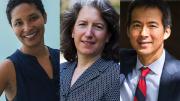The Task Force on Inclusion and Belonging, set up by President Drew Faust in 2016, released its final report this morning, with a broad, University-wide set of recommendations to ensure that Harvard “integrate[s] all members of the University into academic, professional, and social contexts”—by changing the final line of the alma mater, increasing support for mental health services, and forming new research centers on identity, politics, and culture, among other steps. President Faust outlined her response to the report in an email to the University community; it included a $250,000 commitment to fund inclusion initiatives, and $10 million for the hiring of faculty whose work is salient to advancing inclusion.
The report follows a year and a half of research on diversity at the University with respect to race, gender, sexual orientation, and other categories of identity. Faust convened the task force to “recommend programs or initiatives based in an assessment of how we can make progress toward our goal of a community in which everyone may participate as a full member and everyone has the opportunity to thrive.” The group—which included more than 50 people and was co-chaired by Conant University Professor Danielle Allen, vice president for campus services Meredith Weenick, and McCormack professor of citizenship and self-government Archon Fung—was formed during a climate when Harvard and other universities were being asked to address issues of social justice and diversity, particularly racism: Harvard Law School had recently announced that it would drop its shield, which was linked to a slave owner, and undergraduates had created “I, Too, Am Harvard,” a campaign addressing anti-black racism at the University.
“The student bodies across campus have really diversified over the course of the last decade,” Allen said in an interview before the release of the report. “I think lots of people have been doing great work on seeking to ensure that regardless of the background and experience a person brings to campus, they have the opportunity to flourish academically....There was a sense that for all the good work that was happening, there was also still room for improvement to ensure that people had an experience of inclusion on campus and full access to opportunities.”
Harvard’s many efforts to advance diversity have previously been disjointed across the University’s schools, Weenick said in an interview. “There’s been a lot of work at the school level…but what can the University do to advance this work in a cohesive way? We think the end result here really points to a cohesive way of thinking and communicating about the issues.”
The report pulls together the many existing statistics on diversity pertaining to students, faculty, and staff members, which show that the University has diversified greatly with respect to race and gender at the College level, but less so among the faculty themselves and some graduate-school departments. It identifies four main challenges to inclusion on campus:
- not all of Harvard’s schools have diversified their ranks;
- not all members of the Harvard community feel integrated and included;
- Harvard’s increasing diversity has created conflict in some cases, such as among those who believe academic freedom and inclusion are incompatible goals; and
- Harvard hasn’t yet worked out a narrative about its own contributions to past social inequities. “We will need an honest institutional history and efforts to revisit how we weave past to present and future through our repertoire of symbols,” the report reads.
At their listening sessions, Weenick said, task force members learned that “many individuals feel that they’re robust members of this community, and many do not. And that unevenness is worrisome to us.” The feeling of not belonging, she added, “was in many ways felt the most acutely among staff” (as opposed to students and faculty members).
The Task Force’s Agenda
The report makes eight immediate recommendations, including:
- adopting more inclusive symbols and common spaces: the University statement of values will be revised to emphasize inclusion and integration, and the last line of Harvard’s alma mater now reads “Till the stars in the firmament die” instead of “Till the Stock of the Puritans die”—a rephrasing submitted by Janet Pascal ’84, in response to the task force’s call for suggestions;
- creating two University-wide research centers: one on identity, politics, and culture, and one on inclusion and belonging efforts in higher education;
- devoting centralized University attention and resources to mental-health services, to “address disparities in usage and experience of mental health services across different student populations”;
- asking each Harvard school to identify priority areas with respect to inclusion and conduct strategic planning to address those areas;
- coordinating inclusion work for students, faculty, and staff in the offices of the president and the provost;
- improving the ability of the University’s human-resources department to hire more diverse staff members and promote staff;
- measuring the University’s progress toward inclusion on a triennial basis; and
- devoting more resources to faculty development and diversity.
With respect to the last point, Allen said, “If you take a look at things like the [committee on] Ethnicity, Rights, Migration or the history and literature program or social studies—areas that have had curricular innovation—they’re often staffed by lecturers, so the parts of the curriculum that are staffed by ladder faculty have less evolution over time.” According to the report, “In recent years, Schools across the Harvard campus have sometimes met pressures for more rapid evolution of curriculum and research agendas by relying on non-ladder faculty.” The faculty component of the report suggests strategies for appointing more tenure-track faculty whose interests push the boundaries of current research, and whose scholarship is more in line with the interests of students. It recommends hiring faculty in clusters and developing pipelines for graduate students to become faculty members.
In an email to the Harvard community this morning, Faust detailed the immediate steps she will take in response to the report, including devoting $250,000 to grants for innovative programs designed to advance inclusion across the University, and designating $10 million “to help fund new faculty hires who have the promise to make a profound impact on our belonging and inclusion efforts through their scholarship, teaching, backgrounds, and life experiences.” by comparison, Yale committed $50 million to diversify its faculty in 2015, which has supported 50 new hires as of last fall, according to the Yale Daily News.
In consultation with incoming president Lawrence Bacow, Faust has also appointed John S. Wilson, a former president of Morehouse College and member of the Board of Overseers, as a senior adviser and strategist to the president; he will coordinate diversity and inclusion efforts at the presidential level, and devise “the long-term structures and appropriate personnel in the central administration to oversee this work.”
Faust also wrote that she will appoint a group of scholars consider the addition of the research initiatives mentioned in the report and provide funds to University Health Services to assess the demand for mental-health care and “hire staff focused on the specific needs of diverse members of our community.” “[T]he Office of the Provost and the leadership of UHS have recognized that the demographic changes in our community have implications for the delivery of mental health care,” Faust wrote. She has also asked that the art in the new Smith Campus Center “reflect the heterogeneity of today’s Harvard,” asked the deans of Harvard’s schools to create plans for advancing inclusion and belonging, among other steps. Allen will also hold monthly lunches at the Smith Center on civil disagreement, which she describes as “tough-minded conversations on hard issues where broadly divergent opinions are aired and productive discussion is fostered.”
The report provides a framework of four goals through which Harvard’s schools are encouraged to think about inclusion, and devise their plans for improvement: recruiting and retaining diverse talent; integrating its members through strategies like mentoring and responsive curricula; promoting a culture that combines academic freedom with mutual respect; and adopting inclusive symbols and spaces.
Academic Freedom vs. Inclusion?
The task force’s conversations throughout the fall have led to two focus areas that did not appear in its initial draft report released in September, Allen said. First, its many discussions on the relationship between academic freedom and inclusion, she said, have yielded what she describes as “a breakthrough in thinking about these issues: the recognition that academic freedom and inclusion and belonging are mutually reinforcing values to be advanced simultaneously….If you have people in a classroom who can’t participate, who feel pushed out, we don’t have academic freedom.” The report adds: “We may not yet understand all the relevant pedagogic tools for the work of simultaneously upholding principles of academic freedom and inclusion, or how to clarify fully the distinctions between productive discomfort, pointless harm, and actual trauma, but we will find the answers only if we seek them.”
Allen also stressed the intersection of academic advising and mentoring, and students’ access to mental-health resources, an insight that informed the task force’s recommendations with respect to mental health. “Successful, professional mentoring covers a lot of points [for students]: it covers the academic or career pieces, and it also covers the psychosocial dimensions. But some of that latter part is about being able to direct people to counseling resources when necessary, or…to recognize that that issue is a core academic-advising issue. Currently, we don’t succeed terribly well around that interface, and there seem to be quite differential experiences for different categories of students.”
Among the most important products of the task force’s work, Weenick said, is a catalog of 120 best practices in promoting inclusion, drawn from ideas developed across the University. The School of Engineering and Applied Sciences, for example, is developing blind grading on its software platforms (presumably to stem gender bias in grading); Harvard Law School holds faculty workshops on gender and race in the classroom.
“The responsibility of building community does not alone belong to a task force or to a university president; it is incumbent on all of us to do our part, to reach across difference, to find ways to ensure that every person on this campus has the chance to find intellectual, professional, and social fulfillment,” Faust’s email reads. “In that spirit, I look forward to the ‘festival rites’ that will mark this year’s Commencement. When it comes time to sing our alma mater, updated at the suggestion of the task force, I will proudly give voice to the song’s new final line—and its recognition that the pursuit of truth and knowledge belongs to everyone at Harvard, from all backgrounds and beliefs.”
Read the full report here.









